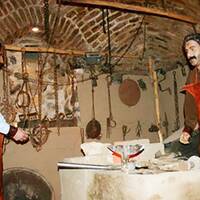
Ethnography Museum of Robat-e Virani
Ethnography Museum of Robat-e Virani was inscribed on the list of Iran National Heritages in 1377 SH that restarted its activity as a museum from 1385 SH. Ribat or caravanserai had been in fact the hostels in old Iran during the past centuries, backing to Achaemenid Empire. These kinds of buildings had many different functions in the past led them to be defined by different names in encyclopedias of Iran such as Timcheh, Karbat, Ribat, Sabat and Khan all meaning caravanserai.
The relatively dry weather in a large part of Iran and the cities and villages being far from each other, made necessary the existence of some spaces for rest and supplying food in the middle of the path without which the travel and the relationship between different regions of the country were impossible. The caravanserai of Ribat-e Virani (literary meaning ruination) is located inside a village with the same name going back to several hundred years ago. It is related to the late Timurid and the early Safavid dynasties, according to the experts. Given the prosperity of East-West trade-in time of Safavid, this period can be named as the peak of establishing caravanserais in Iran. Safavid caravanserais were constructed on the main relational paths between cities so that the caravans reached them after one day of movement. The Museum- Ribat of Virani is located in Shandiz district, Mashhad city, along the way of Nishapur-Tous. It is among the roofed caravanserais without courtyard with nine rooms that are today the exhibition halls. This is one of the most important museums of Mashhad the main purpose of which is improving the position and importance of the local and traditional occupations.
Interesting among these jobs that are displayed using some sculptures are turquoise stone carving, Harkareh carving, making saddle, making گاری, sweep weaving, mat weaving, sheepskin sewing, traditional shoemaking and many more. According to the documents, there were more than three hundred occupations only in Mashhad during the thirteenth century the most important of which are grocery, bakery and agriculture. This museum is the first one in the Great Khorasan specifically dedicated to traditional jobs and occupations.


